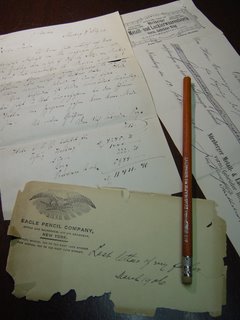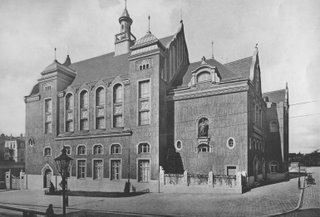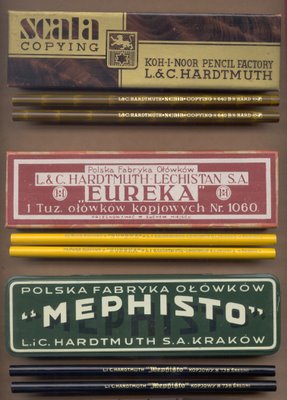 Lieber Philip –
Lieber Philip –
Recently Luigi has been sifting through and organizing, archival family and company correspondence. (for the uninformed Luigi is a retired employee and protégé of my grandfather Charles). Just a week ago he came up with this gem of a letter from my great-great grandfather Heinrich Berolzheimer to his son, my great grandfather and your great-great grandfather Philip.
The letter was written March 7, 1906 and is 100 years old today and begins Lieber Philip just as I’ve started my letter to you. In addition to the handwritten letter in German using a fountain pen there is a receipt from a factory in Nuremburg, Germany for some item Heinrich seems to have purchased on behalf of Eagle Pencil Company in New York. It also included a handwritten note by Philip on an Eagle Pencil Company envelope indicating that this was among the last letters he received from his father before his death. I have added an Eagle Diagraph pencil from my collection as a finishing touch for the photo.
Here is a bit of background history on your great-great-great Grandfather Heinrich, which even you are probably not very familiar with. Heinrich established Eagle Pencil Company in New York after emigrating from Fuerth near Nuremburg, where his father Daniel Berolzheimer had first entered the pencil industry in 1856 in partnership with Leopold Illfelder under the name of Berolzheimer und Illfelder. This 1856 date is commonly considered the founding date of Eagle Pencil Company though the Berolzheimer-Illfelder partnership did not end until approximately 1861 and Eagle was not actually established in New York in 1856. Here’s a link for some information I found on the history of Eagle Pencil Company. There are a few notable errors here with respect to generational relationships of different Berolzheimers to Heinrich but perhaps you’ll learn something new of interest about the pencils side of the family business background here.
After a number of years in New York Heinrich turned the business over to his sons Philip and Emil and returned to Germany for his retirement where he was involved in a number of philanthropic pursuits. This included the construction of a new library for the city of Fuerth in a building which was and is still named the Berolzheimerianum in his honor. This building has in the recent 10 years found new life as a refurbished dinner theater and comedy club. I have not seen a show there myself, but did visit the building ten year ago in 1996 and met the comedy group leaders as they were completing construction and about to open. I was even interviewed on the local television and newspaper during the visit.
Thanks to your aunt Tanja’s help we have been able to decipher the main content of the letter itself. Of particular note are indications that Heinrich had recently received a letter from Philip’s wife Clara with a note from your own great-Grandfather Charles (not quite 4 years old at the time) and that despite his health he was able to sit outside thanks to unseasonably warm weather for that time of year. The letter also includes a summation of a few financial figures in German Marks. One figure is the amount of 222.20 Deutch Marks from the included receipt from Nurnberger Mettal und Lackierwaarenfabrik, apparently a supplier of metal and lacquer materials to the pencil industry.
Given the 100 year anniversary of this letter today I thought it might be interesting to share with you what I see as a few of the interesting changes and developments in 100 years time that are reflected in the letter. The first is the change in language and handwriting itself. In interpreting the letter Tanja indicated there has been significant change in the meaning of particular words which she refers to as “old German”. Also, the style of handwriting includes a number of letters which appear to be one letter if using current writing style, but were actually read as different letters at that time. This could even change the meaning of some of the words and sentences if interpreted improperly.
The age and somewhat faded nature of the ink complicated Tanja’s task and made at least one sentence totally unclear and she was unable to translate due to a variety of potential meanings of the few legible words. One wonders if this letter had been written with a graphite pencil rather than ink would it be more smudged or would it have stood the test of time. Given the clear legibility of the graphite pencil note by Philip on the back of the letter that indicates the date he answered the letter I could make an argument for pencil over ink. How about this? “Ride the Palomino, the mark that will last over 100 years.“
I was curious what the current value of the receipt for 222.2 Marks would be in US dollars today. With the help of this site I was able to estimate it was worth approximately US$53 in 1906 using the pre-WWI rate of exchange. Using this second site it appears this amount in 1906 would be roughly equivalent to US$1085 today. Just think if you would begin setting aside just $53 per year today for the rest of your life what it might mean for your great-great grandchild in 100 years time.
Unfortunately, the description tied to this amount simply has the title “Brother Bing” so it’s unclear what this receipt is specifically for. I had hoped to estimate what the cost of some parts or equipment would be today. By the way I have no knowledge of any relative named Bing, just in case you were wondering. Of further interest to me is the timeframe involved in trans-Atlantic mail communications 100 years ago. The letter dated March 7, 1906 was received in New York and Philip’s handwritten note indicated he answered back with his own letter on March 20th. So a maximum of 13 days time for delivery. An eternity compared to the near instantaneous responses we expect today using e-mail for business to our factories in China and Thailand and that you and I use for personal communication. I can’t remember the last real hand written letter I sent or received via mail. I’m guessing your wondering when you ever received a written letter of any sort from me. I guess this electronic version will have to suffice.
A final note of interest is the signoff which reads “Your Loving Grandfather”, using the word “Opa”, though we know the relationship was father writing to son. Perhaps the translation and meaning of the word could have simply changed in 100 years time. Whether this is it or this implies some form of senility in Heinrich’s waning years or was simply used as a term of endearment is unclear. I’m sure by now you are wondering about my own state of mind writing an open letter to you my teenage son in a post for the world to see on my blog. In any case the use of this language seems warm and heartfelt though sadly not typical these days of what I would expect to receive in a note or e-mail from my father Philip or I expect what you would anticipate receiving from me. Since I’m feeling nostalgic and perhaps in time you’ll reread this and feel this way too I suppose you’ll eventually forgive me if I follow the example of our forefather Heinrich.
Lour loving father,
Charles





















